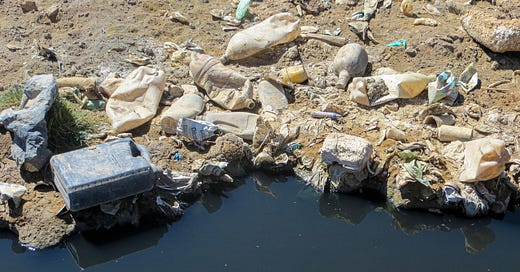Let me start with this basic question: Do you know where your water comes from?
Think about it. Try to trace it back from the faucet, all the way through the twisted network of pipes through your house or condo or apartment building and into the ground.
Perhaps you have a house on a well and the pipe runs toward an overgrown borehole in the yard, down into the mysterious pore space of the aquifer beneath. Or, perhaps your mental line goes out under the street, then across the city every which way until it reaches a treatment plant. Keep tracing it backwards through the various basins, pumps, and valves until you reach the intake on the other side. Imagine it—what’s there? A hole in the ground? A mighty river? A vast reservoir? A muddy ditch full of crawdads? (This last one is where I end up).
Now try to answer this: is that water “safe”? Meaning, is it protected from the offscouring of society? You know: industrial waste, human sewage, runoff from roads, rotting old tires. And subsequently, do the processes that guide it from source to tap ensure that it is clean by the time it reaches your faucet? Are there any barriers between you and that hole in the ground at all?
Most likely, if you live in a city, the answer is yes. Yes, there are probably some source protections in place. Yes, the existing treatment processes are probably adequate. Yes, there are multiple barriers of protection. For most people, interlocking systems of nature, technology, and governance fit together like puzzle pieces to ensure water is reasonably safe to drink when it finally reaches the tap.
For others, though, those processes do fail. Chemicals spill. People make mistakes. Pipes corrode. Sewers overflow. Fires rage. Things just break. For still others, like many private well users, there is nothing to fail in the first place; what comes out of the tap is the full, unmitigated cocktail of whatever water, the ever-welcoming solvent, has picked up along the way.
The point here is to envision the process: the twists and turns and snags of it.
The feats of engineering and the enduring vulnerabilities. Healthy and sick, children and elderly, rich and poor, White and Black, citizen and immigrant, urban and rural: we all are on the receiving end of a labyrinthine journey from source to tap (and back around). We live from this substance that, if we could truly see what it sees on its never-ending cycle, we would stand in awe at the complexity, interconnectedness, and human ingenuity involved. And also, maybe, horror at the messiness, the fragility, and the simple unfairness we would witness.
Take, for example, the fact that in the United States nearly half a million households (almost 1.5 million people) are estimated to lack indoor plumbing at all. We would see these families filling buckets from unprotected springs, hauling water from old wells, lugging grocery carts full of bottled water while many of their neighbors quietly open the faucet. Who are these people? Some researchers looking at U.S. Census data found that they are, more often than not: American Indian and Alaskan Natives. Black. Hispanic. Renters. Low-income. Do you know some of them?
We might see this more clearly too: toxic chemicals in fire fighting foam sprayed onto a blazing fuel fire, perhaps decades ago, slowly, stealthily, inexorably weaving through the earth to finally come across—what’s this?—a well screen. Up it goes, into the unsuspecting well owner’s glass, or coffee, or baby formula. Or, we would watch as the protective scale inside thousands of pipes in Flint, Michigan crumbled and dissolved, baring the long-ignored lead pipes beneath. Elsewhere, we might bump shoulders with some of the nastiest human pathogens: Vibrio cholerae, Cryptosporidium parvum, Legionella pneumophila, silently infiltrating, looking for a host.
The study of water quality gives us glimpses of what water sees in its path. It can tell us about the nature of pollution, risk, public health, and inequality. As a group of students and researchers, the Equal Water Lab will be a place to explore these glimpses. We will look at when, where, and how water quality risks emerge, and what can be done about it. We will consider the ways in which we can predict whose water is safe and whose isn’t (sometimes with remarkable accuracy) just from different social realities. We will look at how water quality challenges affect real communities, and the decisions they must make. We will dig into new research and try to make sense of it. And, as we follow our noses, we will almost certainly wander and muse into other environmental health topics.
But here at the beginning, I want to know: as you follow your water, what questions do you have? What concerns you? How and where can our research have impact and shed light? Let me know in the comments below, and subscribe to follow our work.




